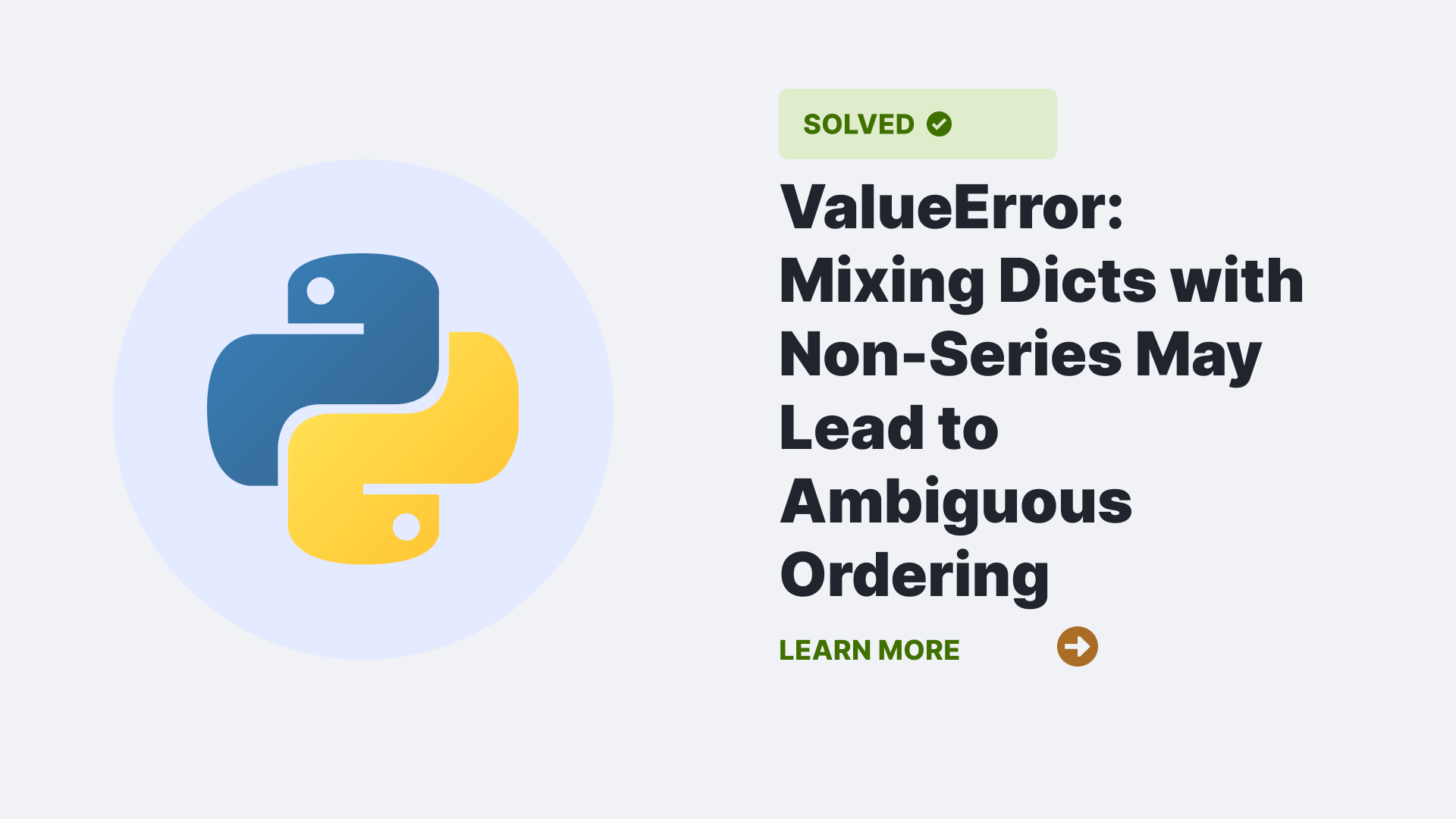In the realm of data manipulation and analysis, Python’s Pandas library is a powerful tool. It allows data scientists, analysts, and programmers to demonstrate a wide range of operations on their respective data with ease. However, as is often the case with powerful tools, there can be pitfalls and challenges. One such challenge is the “ValueError: Mixing Dicts with Non-Series May Lead to Ambiguous Ordering” error. This error can be confounding, especially for those new to Pandas. In this article, we will learn about the causes of this error, provide code examples to illustrate these causes, and offer solutions to help you resolve it.
Contents
- 1 What is the “ValueError: Mixing Dicts with Non-Series May Lead to Ambiguous Ordering”?
- 2 What Causes the “ValueError: Mixing Dicts with Non-Series May Lead to Ambiguous Ordering”?
- 3 How to Resolve the “ValueError: Mixing Dicts with Non-Series May Lead to Ambiguous Ordering”?
- 4 FAQs
- 5 Conclusion
- 6 Reference
What is the “ValueError: Mixing Dicts with Non-Series May Lead to Ambiguous Ordering”?
The “ValueError: Mixing Dicts with Non-Series May Lead to Ambiguous Ordering” is a common error encountered when working with Pandas DataFrames. It typically occurs when you are trying to combine or merge two DataFrames that have mixed data types, specifically when mixing dictionaries and non-Series data. This error message can be intimidating at first, but it essentially means that Pandas is still determining how to handle the merging or combining operation due to the heterogeneous data types involved.
What Causes the “ValueError: Mixing Dicts with Non-Series May Lead to Ambiguous Ordering”?
Let’s break down the causes of this “ValueError: Mixing Dicts with Non-Series May Lead to Ambiguous Ordering” error error into more specific scenarios:
Combining DataFrames with Overlapping Column Names
When you attempt to combine two DataFrames with overlapping column names, and one of them is a dictionary while the other is not, Pandas might encounter issues. This is because Pandas is uncertain about how to merge columns with the same name but different data types.
Syntax:
import pandas as pd
# Create two DataFrames with overlapping column names
df1 = pd.DataFrame({'A': [1, 2, 3]})
df2 = pd.DataFrame({'A': {'a': 4, 'b': 5, 'c': 6}})
# Check if columns have overlapping names
if any(df1.columns.isin(df2.columns)):
raise ValueError("Mixing DataFrames with overlapping column names may lead to ambiguous ordering")
# Attempt to combine them
result = pd.concat([df1, df2], axis=1)Merging DataFrames with Non-Uniform Indexing
If the DataFrames you are trying to merge have non-uniform indexing, you may encounter the “ambiguous ordering” error. This issue arises because Pandas can’t confidently determine the appropriate alignment of rows between the DataFrames.
Syntax:
import pandas as pd
# Create two DataFrames with different indices
df1 = pd.DataFrame({'A': [1, 2, 3]}, index=[0, 1, 2])
df2 = pd.DataFrame({'B': {'a': 4, 'b': 5, 'c': 6}})
# Check if the DataFrames have overlapping indices
if any(df1.index.isin(df2.index)):
raise ValueError("Mixing DataFrames with overlapping indices may lead to ambiguous ordering")
# Attempt to merge them
result = pd.merge(df1, df2, left_index=True, right_index=True)How to Resolve the “ValueError: Mixing Dicts with Non-Series May Lead to Ambiguous Ordering”?
To resolve the “ValueError: Mixing Dicts with Non-Series May Lead to Ambiguous Ordering,” you have several options, depending on the specific circumstances. Here are some common solutions:
Specify How to Handle the Ambiguity
You can explicitly tell Pandas how to handle the ambiguity when merging DataFrames. For example, you can use the ‘suffixes’ parameter to add a suffix to overlapping column names.
Syntax:
import pandas as pd
# Create two DataFrames with overlapping column names
df1 = pd.DataFrame({'A': [1, 2, 3]})
df2 = pd.DataFrame({'A': {'a': 4, 'b': 5, 'c': 6}})
# Rename the columns to avoid overlap
df1.columns = ['A_df1']
df2.columns = ['A_df2']
# Combine the DataFrames
result = pd.concat([df1, df2], axis=1)
Reset Index or Ensure Matching Index
If you encounter the error due to non-uniform indexing, consider resetting the index or ensuring that both DataFrames have the same index.
import pandas as pd
# Create two DataFrames with different indices
df1 = pd.DataFrame({'A': [1, 2, 3]}, index=[0, 1, 2])
df2 = pd.DataFrame({'B': {'a': 4, 'b': 5, 'c': 6}})
# Reset the index of df2 or set a common index
df2.reset_index(inplace=True) # Resetting the index
# Merge DataFrames on the 'index' column
result = pd.merge(df1, df2, left_index=True, right_on='index')
FAQs
What does “ambiguous ordering” mean in the context of this error?
“Ambiguous ordering” implies that Pandas is uncertain about how to align or order the data when combining DataFrames with mixed data types. It can’t determine which data should be placed where due to the differences in data structures.
Can I avoid this error by ensuring consistent data types in my DataFrames?
Yes, ensuring that the DataFrames you intend to merge or combine have consistent data types can help avoid this error. Maintaining uniformity in your data can simplify the data manipulation process.
Are there any performance implications when handling this error?
While resolving the “ambiguous ordering” error, you may introduce additional processing steps, such as adding suffixes to column names or resetting indices. These steps can impact performance, especially when dealing with large datasets. It’s essential to consider the trade-offs between data consistency and performance.
Conclusion
The “ValueError: Mixing Dicts with Non-Series May Lead to Ambiguous Ordering” error is a standard stumbling block in Pandas data manipulation. However, with a clear understanding of its causes and the appropriate solutions, you can navigate through it effectively. It’s essential to be mindful of data consistency and use the available options, such as specifying suffixes or ensuring matching indices, to handle this error gracefully. Pandas is a versatile library, and by mastering its intricacies, you can become a more proficient data analyst or scientist.
Reference
Follow us at PythonClear to learn more about solutions to general errors one may encounter while programming in Python.

